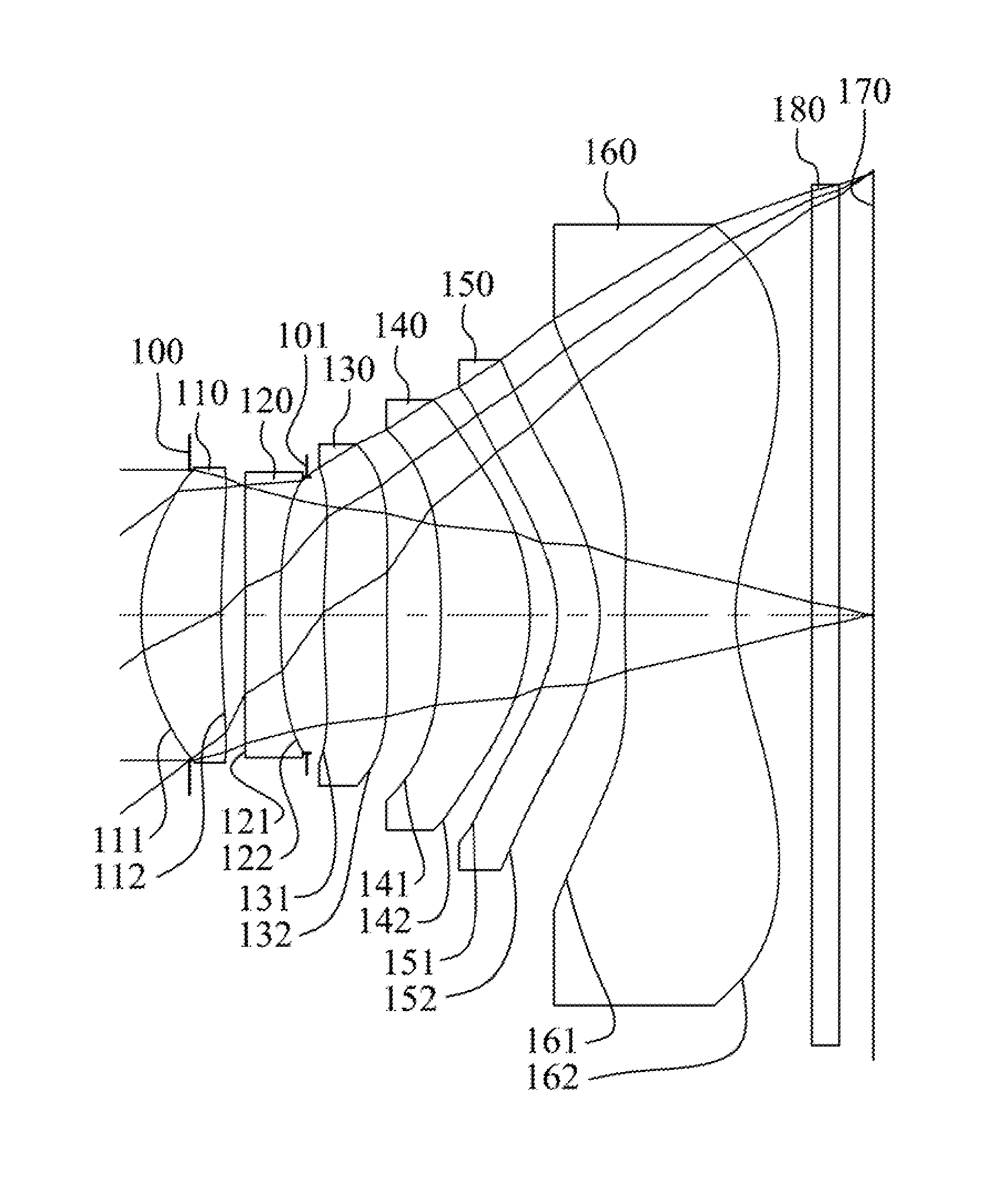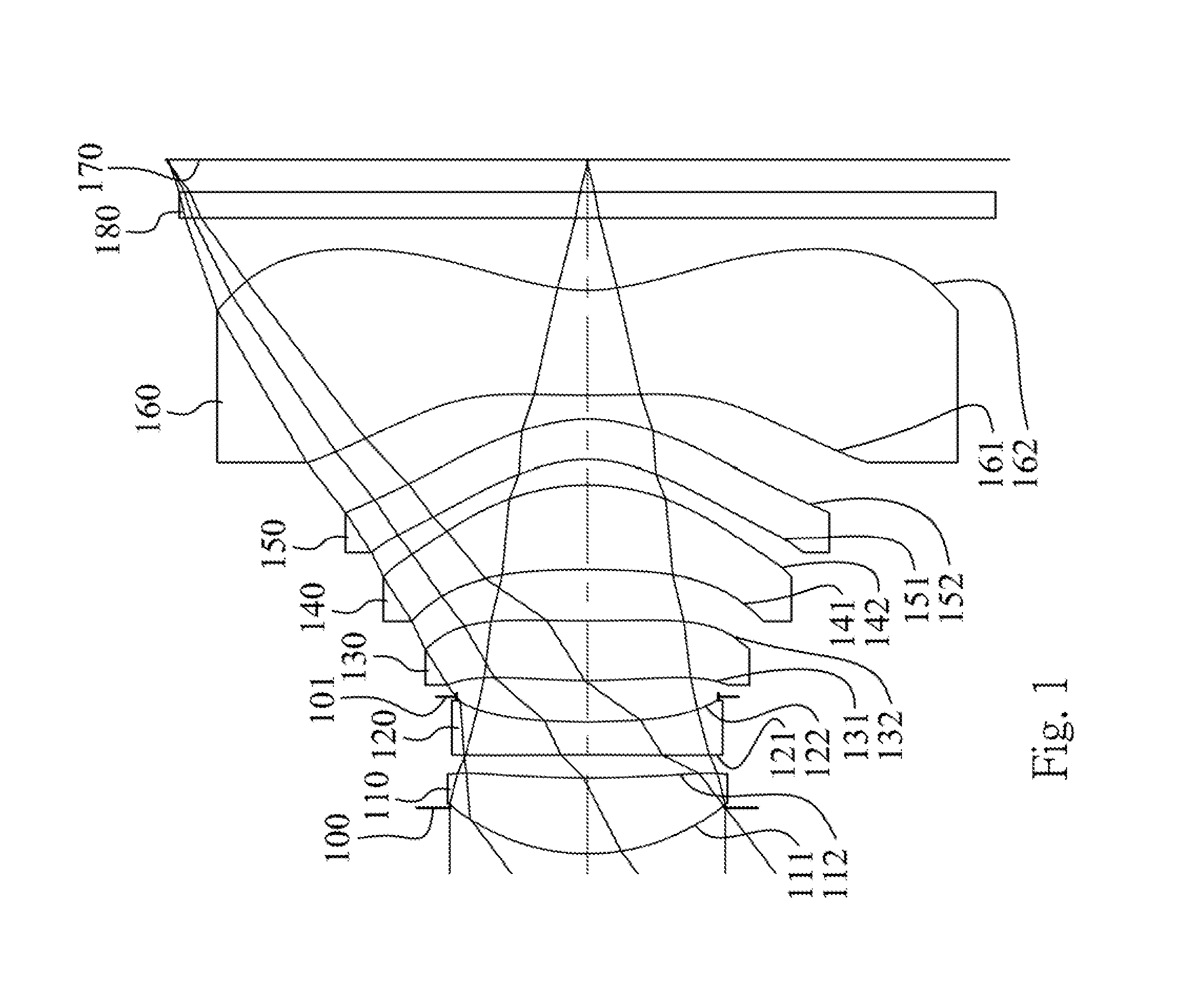Imaging lens assembly
a technology of imaging lens and assembly, which is applied in the field of compact imaging lens assembly, can solve the problems that the refractive power of the first lens element is not favorable for reducing the total track length, the surface shape together with the allocation of stop is also not favorable for light gathering capability
- Summary
- Abstract
- Description
- Claims
- Application Information
AI Technical Summary
Benefits of technology
Problems solved by technology
Method used
Image
Examples
1st embodiment
[0051]FIG. 1 is a schematic view of an imaging lens assembly according to the 1st embodiment of the present disclosure. FIG. 2 shows spherical aberration curves, astigmatic field curves and a distortion curve of the imaging lens assembly according to the 1st embodiment. In FIG. 1, the imaging lens assembly includes, in order from an object side to an image side, an aperture stop 100, a first lens element 110, a second lens element 120, a stop 101, a third lens element 130, a fourth lens element 140, a fifth lens element 150, a sixth lens element 160, an IR-cut filter 180 and an image plane 170, wherein the imaging lens assembly has a total of six non-cemented lens elements (110-160) with refractive power.
[0052]The first lens element 110 with positive refractive power has a convex object-side surface 111 and a concave image-side surface 112. The first lens element 110 is made of plastic material, and has the object-side surface 111 and the image-side surface 112 being both aspheric.
[005
2nd embodiment
[0080]FIG. 3 is a schematic view of an imaging lens assembly according to the 2nd embodiment of the present disclosure. FIG. 4 shows spherical aberration curves, astigmatic field curves and a distortion curve of the imaging lens assembly according to the 2nd embodiment. In FIG. 3, the imaging lens assembly includes, in order from an object side to an image side, an aperture stop 200, a first lens element 210, a second lens element 220, a stop 201, a third lens element 230, a fourth lens element 240, a fifth lens element 250, a sixth lens element 260, an IR-cut filter 280 and an image plane 270, wherein the imaging lens assembly has a total of six non-cemented lens elements (210-260) with refractive power.
[0081]The first lens element 210 with positive refractive power has a convex object-side surface 211 and a concave image-side surface 212. The first lens element 210 is made of plastic material, and has the object-side surface 211 and the image-side surface 212 being both aspheric.
[008
3rd embodiment
[0093]FIG. 5 is a schematic view of an imaging lens assembly according to the 3rd embodiment of the present disclosure. FIG. 6 shows spherical aberration curves, astigmatic field curves and a distortion curve of the imaging lens assembly according to the 3rd embodiment. In FIG. 5, the imaging lens assembly includes, in order from an object side to an image side, an aperture stop 300, a first lens element 310, a second lens element 320, a stop 301, a third lens element 330, a fourth lens element 340, a fifth lens element 350, a sixth lens element 360, an IR-cut filter 380 and an image plane 370, wherein the imaging lens assembly has a total of six non-cemented lens elements (310-360) with refractive power.
[0094]The first lens element 310 with positive refractive power has a convex object-side surface 311 and a concave image-side surface 312. The first lens element 310 is made of glass material, and has the object-side surface 311 and the image-side surface 312 being both aspheric.
[0095]
PUM
 Login to view more
Login to view more Abstract
Description
Claims
Application Information
 Login to view more
Login to view more - R&D Engineer
- R&D Manager
- IP Professional
- Industry Leading Data Capabilities
- Powerful AI technology
- Patent DNA Extraction
Browse by: Latest US Patents, China's latest patents, Technical Efficacy Thesaurus, Application Domain, Technology Topic.
© 2024 PatSnap. All rights reserved.Legal|Privacy policy|Modern Slavery Act Transparency Statement|Sitemap



